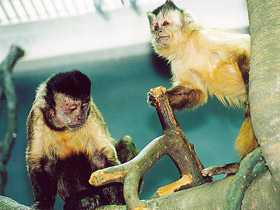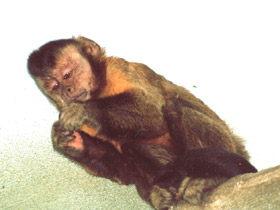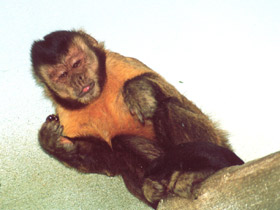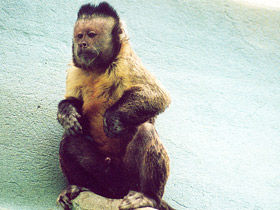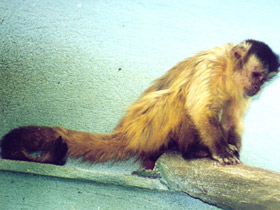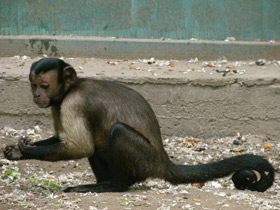The tufted capuchin (Sapajus apella), brown capuchin, black-capped capuchin, or pin monkey
The tufted capuchin (Sapajus apella), also known as brown capuchin, black-capped capuchin, or pin monkey, is a New World primate from South America and the Caribbean islands of Trinidad and Margarita. As traditionally defined, it is one of the most widespread primates in the Neotropics, but it has recently been recommended considering the black-striped, black and golden-bellied capuchins as separate species in a new genus, thereby effectively limiting the tufted capuchin to the Amazon basin and nearby regions.
Appearance
Sapajus apella is a platyrrhine primate from South America. It is the largest of all capuchins: an adult animal can weigh up to 4.8 kg (sometimes up to 6.8 kg); body length 30-35 cm, tail 30-56 cm. Males are usually larger than females. The colour of the body coat varies from dark brown and mustard yellow to black. The face has a slight red tinge. The shoulders are lighter than the rest of the body. On the head, above the ears, the hair is straight and long, black, forming two tufts, hence the second name of this species. The brown capuchin is the only species that curls its long tail into a ring. The tassels, legs and tail are black or dark brown.
Habitat
Sapajus apella is currently found in the following countries: Argentina, Bolivia, Brazil, Colombia, Ecuador, French Guiana, Guyana, Paraguay, Peru, Suriname and Venezuela. They inhabit tropical or subtropical forests, but are found in dry and gallery forests. In north-western Argentina, these monkeys live in mountain forests at an altitude of 200-1100 m. Capuchins are diurnal. They move on four limbs, climb deftly up trunks and jump nimbly from one tree to another. Capuchins have short arms and legs and can jump 3 to 4 metres. These primates can walk on two legs for a short distance, carrying food in their hands. When moving on all fours, capuchins use their tail as an additional fifth limb.
Social behaviour
Sapajus apella are kept in groups of 10-30 individuals in a defined area of 25-40 ha (sometimes up to 355 ha). The group usually has the same number of males and females, but sometimes there are more females. There is a separate hierarchy between males and females. Although other capuchin species are extremely territorial, brown capuchins are more tolerant of their neighbours. Their territories often overlap, by about 40%, and different groups may forage peacefully side by side in border areas. A group usually explores an area of about 2000 square metres in a day. The dominant male's duty is to guard the core territory against intruders by emitting high-pitched, loud cries to indicate that the territory is occupied. The dominant male does not control the group, but only protects it. If another group of capuchins appears, the leader will organise an attack against them. He will also gather and lead the other males in the group to attack another group of capuchins, for example, in the case of a confrontation in a fruit tree. The dominant male is always actively protective of the young, of which he is probably the father, but is aggressive towards males born before his possession and dominance of the group. Members of each capuchin group are closely related to each other, but males sometimes change groups. The dominant male has priority in choosing the females and the best food. He starts eating first, and with him the closest members of the group, the subordinates, wait their turn. The cronies are the young, the calves and the females. The leader is hostile to the offspring of former leaders. Most of the aggression in the group is caused by the feeding process. This is always accompanied by noise and rubbing. Capuchins move from tree to tree, eating parts of edible plants, cracking nuts and hunting vertebrates. They do not share their prey with others.
Reproduction
Although capuchins do not have a specific breeding season, females usually give birth during the dry season or at the beginning of the rainy season, i.e. the breeding season is mainly between April and July. Generally, a female gives birth to a young once every two years. Sapajus apella are polygamous. Although males are larger and often dominant, females decide for themselves when and with whom to mate. Females in oestrus (gona), when at the peak of their receptivity, actively pursue the group leader and emit loud calls. She follows the dominant male and "seduces" him by clear calls, displays and postures: raised eyebrows, facial expressions, etc.
The male, interested in courting the female, often imitates her gestures by emitting a high-pitched song. Mating occurs only once a day. For the next two days, the dominant male "guards" the female from subordinate males in the group and does not allow other males to approach her, and then, when the female's receptivity decreases, he stops guarding her. At this point, the female begins to chase subordinate males, mating with them for up to six more days. In this way, females procreate with the head of the herd, while other males have the opportunity to do so only in the absence of the main male.
After 160-180 days of gestation, a calf is born weighing 200-250, which is 8.5% of the mother's body weight. The newborn is completely covered with hair, but is helpless and firmly attached to its mother's coat for the first 5 weeks. The pup remains in the mother's womb for the first while and then moves to her back or shoulders as it grows. After reaching 8 weeks of age, the calf begins to move from place to place independently and autonomously, but to reassure itself, it sticks to the mother with its hand or tail clutch. It continues to ride its mother until it is 3 months old.
Although it can now eat some solid food, the baby is still completely dependent on its mother. It continues to nurse and remains close to its mother at all times until 9-12 months of age.
Mothers are responsible for raising the young, while males are tolerant of their young. The young have a long period of adolescence and during this time they master all the skills so necessary for survival in the forest. Generally, young females after reaching puberty (at 4 years, males at 8 years) remain in their mother's group, while young males leave the family group and go in search of a new one. They try to join other groups by competing with other males for the right to mate with females. Some males (more often young males) are traumatised by these aggressive confrontations.
Nutrition
Sapajus apella use consistent routes through the forest canopy to find food, sticking to their home range and not wandering long distances. They usually walk up to 2,000 m a day.
They usually wander in a certain order: young go first, males and females go next, and mothers with their young complete the procession. These capuchins have the broadest diet of all New World monkeys. They have a preference for fruit, and are able to eat large fruits thanks to their particularly strong jaws and teeth.
Although capuchins do not have opposable thumbs, their hands are very agile and can quickly manipulate and dismantle small objects. Therefore, they actively search for debris: insects and small animals under loose bark, in twisted shoots, under trunks, in hollow vines, in leaf litter and in piles of plant debris. Sometimes they may actively hunt smaller, weaker animals, such as bird chicks, squirrels, lizards, bats and other mammals weighing up to 1 kg. During the dry season, when food supplies are limited, capuchins eat the palm heart of the Scheelea palm.
The brown capuchin's menu, according to one study, includes about 65% fruit, 25% seeds, 7% other plant food, 1% nectar and 1% insects, spiders and small animals. Capuchins living in mangroves also feed on crustaceans, oysters and other marine animals.
Sapajus apella has large square molar teeth with a thick layer of enamel that help it crack nuts easily. Its methods for cracking nuts or other hard shells include using a "tool" such as a stone to break open the shell, or using the nuts to bang against tree branches or each other to get to the kernel of the nut. Sapajus apella feed mostly in trees, although they often come down to the ground to drink or play, or to move to other food sources, sometimes in crop fields, where they cause damage to crops. Sapajus apella drink water every day, usually found in tree cavities or bromeliads. Sapajus apella feed actively in the early morning and late afternoon, while in the evening they go to sleep. At night, they sleep together in small groups in the tops of tall trees.
Сontenido
Sapajus apella are often kept in captivity and at home, and are often shown in television programmes and films. They are sometimes trained to work with paralysed people or to act as guides for the blind. A Sapajus apella has lived at the San Diego Zoo for about 40 years; in the wild, Sapajus apella usually live up to 15-20 years.

















